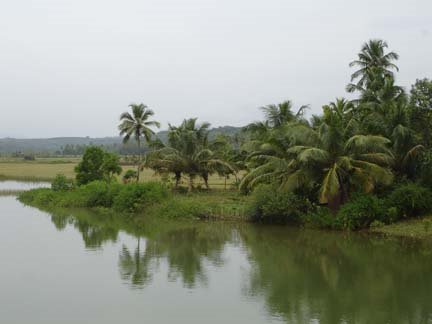What is striking about the word ‘Manja’?
It means different things to different people, regions and culture. It needs no illustration for those who know
about it. To give just an example, ‘manja’
in kite flying is known to everybody, particularly in Maharashtra and
Gujarat. Here ‘manja’ is a special
string, smeared with glass powder, to give it a cutting edge in kite fighting.
‘Manja’ in Tulu
‘Manja’ in Tulu language of coastal Karnataka and Kasaragod (Kerala)
means generally an ‘elevated place’. There are many usages of Manja, as documented
painstakingly in Tulu Lexicon by scholars.
1. Kayimanja:
Kaimanja is a small shrine for departed souls,
also known as ‘Kayimada’. On the burial
place, a mound is made so as to place food, offered to manes. Well-to-do people make a shed-like structure
for this purpose.
 |
| Kadri Kambla 2010, Mangalore |
2. Manjotti: In
Kambala (Buffalo race), it is a raised place at other end of buffalo race
slushy field. It is a reaching point for
buffalo as speedily as possible with adept handling by handler. Speed is measured by time. Pair of buffalos taking the least time is
declared a winner. Winning buffalos are
known as ‘Manjottigone’. There is a folk
narration (PadDana) by name ‘Manjottigona’, which tells about exploits of a
young he-buffalo and its tragic end.
This song is sung in group by women in agriculture field while planting
nursery plants of paddy. It is sung when
buffalos are not around.
Coming to spirit worship, it means a
purification ritual to ward off pollution of the shrine.
3.
Ritualistic
act: Tuluvas are animists. ‘Manja’ is an archaic use in worship of Divine
Spirits in Tulunadu. Manja ritual is a
vow fulfilled periodically or on special occasions for appeasement of Divine
Spirits of household, village or group of villages (Maganes). There are several
Bhutas (Divine Spirits), exploits of whose are described in respective
PadDanas, a kind of Tulu literature orally preserved. It is a custom (which is
in vogue in Tulunadu) of offering meat (chicken), fish, etc. (with toddy in
certain cases). The ritual is known as ‘Manja Balasuni/Malpuni’.
In Siri Festival, a main and lengthy
ritualistic celebration, ‘Manja Balasuni’ to Siri Kumara is a less known
performance. RRC News Bulletin of
Jan-March 2003 throws light on this performance (q.v. Prasanga –
Udupipages.com).
4 Place
& personal names: Manja is
used in place names, such as Kalmanja, Ballamanja, etc., with specific meaning
of ‘elevated place’. Probably, Kalmanja
means a village, beset with rocky mounds and Ballamanja, a high place, full of
creepers and bushes.
As for popular names, we can cite Manja and
Manjanna as male proper names and Manjakka, a feminine name. Probably, giving these names has some bearing
on physiques.
5 Times
of a day: Manja is used either for evening, darkness or
early morning. So it indicates different shades of light as day proceeds.
6 Raised
Platform in market: Primarily,
it means a ‘raised platform’ for a seller. So, ‘Manja’ literally means a
market-place.
7 Engagement
Feast: ‘Manja’ is used for a
ceremonial feast in bride’s place on consummation of an engagement. In these
days, we do not hear this word for the function. It is now just an engagement party in a hotel.
Manjarur
The
term ‘Manja’ has been explicitly used in several Tulu place names. Mangalore
was known as Manjarur especially during 10th and 11th Century CE. Manjanadi
is a village in Mangalore Taluk, bordering with Kerala. There are several Manjanakatte,
Manjara pāde, Manjarapalke, etc hamlets across Tulunadu.
Similar
analogous names exist in Uttara Kannada district also. For example Manjuguni
near Ankola.
The
Lord of Kadri Temple, Mangalore is well known as Manjunatha. The Lords name was
later replicated in now renowned Dharmastala temple. Manjeshwara is a coastal
town in Kasargod Taluk, south of Mangalore. There is a locality known as
Vamanjur in Mangalore as well as in Manjeshwara. In earlier posts we interpreted
that’ Vamanjur’ could have been originally Om-manjur, named after immigrant Om
tribes of Africa.
Manjanna,
Manjappa, Manjamma etc proper names were common in Tulunadu and adjoining Kannada areas. These may have an obscure tribal heritage that needs to be explored further. The proper name 'Manja' in these could possibly be traced to an ancient Paisachi-Prakrit word 'manja' that represented man (Post 261). The old word 'manja' evidently evolved into 'manuja' with passage of time.
Words are not dead objects, though they undergo changes with passage of time. They live with people of a region, state and
country, perpetuating the extant beliefs, traditions and culture. This is manifest on
exploration of ‘manja’, pertaining to Tulunadu.
Sometimes, in the antiquity the words have crossed borders to remote countries or words in usage in different continents may had similar roots to begin with.Note for example: An 'Igloo' means a hut/house made of ice blocks among the Eskimos. Another parallel word 'Illu' in Tulu and some of the other Dravidian languages means a dwelling place.
Sometimes, in the antiquity the words have crossed borders to remote countries or words in usage in different continents may had similar roots to begin with.Note for example: An 'Igloo' means a hut/house made of ice blocks among the Eskimos. Another parallel word 'Illu' in Tulu and some of the other Dravidian languages means a dwelling place.
-Hosabettu Vishwanath, Pune
link: Omanjur, forgotten word


